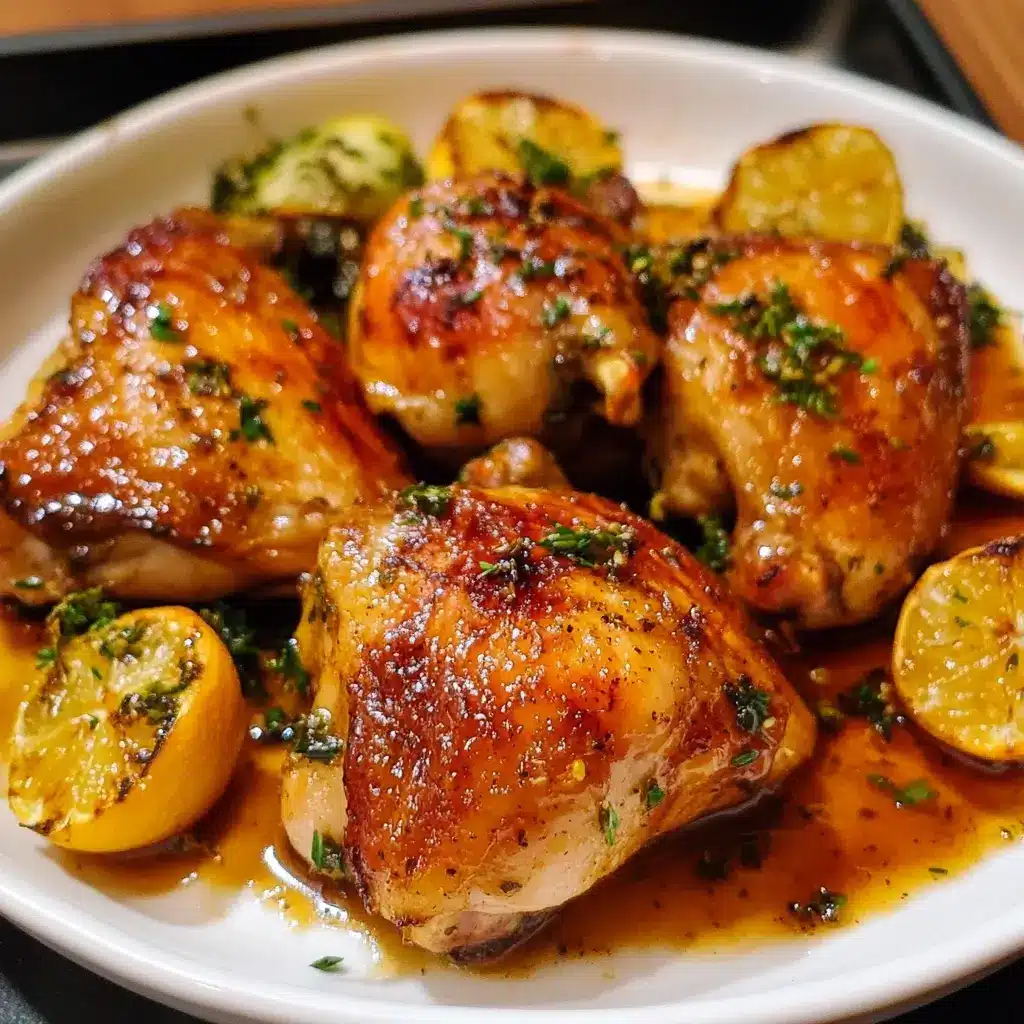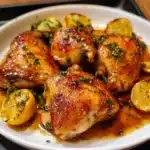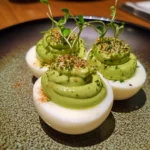There’s something truly magical about the aroma of a roasting chicken wafting through the house on a Sunday afternoon. It speaks of comfort, togetherness, and the simple joy of a delicious meal shared with loved ones. For years, our Sunday roasts were pretty standard fare – flavorful, yes, but perhaps lacking a certain zing. That was until I stumbled upon this Citrus Glazed Roasted Chicken recipe, and let me tell you, it was a game-changer. The first time I made it, the bright, tangy scent of citrus filled the kitchen, promising something special. And it delivered in spades! The chicken emerged from the oven beautifully bronzed, with a glistening glaze that was both sweet and savory. My family, usually a tough crowd to impress with new dishes, devoured it. Even my youngest, who is notoriously picky, asked for seconds (and thirds!). The citrus glaze, with its vibrant blend of orange, lemon, and a hint of ginger, elevated the humble roasted chicken to a whole new level of deliciousness. It’s become a regular feature on our Sunday table, and I’m thrilled to share this recipe with you, hoping it brings as much joy and flavor to your home as it has to ours.
Ingredients for Citrus Glazed Roasted Chicken
- Whole Chicken (4-5 lbs): The star of the show! Choose a good quality whole chicken, preferably air-chilled for crispier skin. A 4-5 pound chicken is ideal for feeding a family of 4-6.
- Fresh Oranges (2 large): We’ll need both the zest and juice of these sunny fruits. Oranges provide the foundational citrus sweetness and a vibrant aroma to the glaze.
- Fresh Lemons (2 medium): Lemons add a necessary tanginess and brightness to balance the sweetness of the oranges and honey, creating a complex and zesty flavor profile. We will use both the zest and juice.
- Honey (1/4 cup): The natural sweetener that adds a beautiful golden hue and sticky texture to the glaze. Honey also complements the citrus flavors perfectly. You can use your favorite type of honey, such as wildflower or clover.
- Olive Oil (1/4 cup): Adds richness and helps the glaze adhere to the chicken. Olive oil also contributes to the crispy skin we all crave. Use a good quality extra virgin olive oil for the best flavor.
- Soy Sauce (2 tablespoons): A secret ingredient that provides umami depth and a savory counterpoint to the sweetness and citrus. Low-sodium soy sauce is recommended to control the salt content.
- Fresh Garlic (3 cloves): Aromatic and pungent, garlic infuses the glaze with a savory depth that complements both the citrus and the chicken. Minced finely for even distribution.
- Fresh Ginger (1 tablespoon, grated): Adds a warm, slightly spicy, and incredibly aromatic note that elevates the glaze and cuts through the richness of the chicken. Fresh ginger is crucial for the best flavor.
- Salt (1 tablespoon): Essential for seasoning the chicken and enhancing all the flavors in the glaze. Kosher salt or sea salt is recommended.
- Black Pepper (1 teaspoon): Ground black pepper adds a subtle spice and depth of flavor. Freshly ground black pepper is always preferred.
- Paprika (1 teaspoon, optional): Adds a touch of color and a mild smoky note to the chicken. Smoked paprika can be used for a more pronounced smoky flavor.
- Fresh Parsley (for garnish, optional): Adds a pop of fresh green color and a final touch of herbaceousness when serving.
Instructions for Making Citrus Glazed Roasted Chicken
- Prepare the Chicken: Preheat your oven to 375°F (190°C). Remove the chicken from its packaging and take out any giblets or neck that may be inside the cavity. Pat the chicken thoroughly dry with paper towels, both inside and out. This step is crucial for achieving crispy skin. Drying the skin removes excess moisture, allowing for better browning and crisping during roasting.
- Make the Citrus Glaze: In a medium-sized bowl, whisk together the freshly squeezed juice and zest of both oranges and lemons. Add the honey, olive oil, soy sauce, minced garlic, and grated ginger to the bowl. Whisk all the ingredients together until they are well combined and emulsified, creating a smooth and fragrant glaze. Taste the glaze and adjust seasonings if needed – you might want a touch more honey for sweetness or a pinch of salt for balance.
- Season the Chicken: Generously season the entire chicken, inside and out, with salt, pepper, and paprika (if using). Ensure you rub the seasoning all over the skin and inside the cavity. Proper seasoning at this stage is vital for flavorful chicken. Don’t be shy with the salt and pepper!
- Glaze the Chicken: Using a pastry brush or spoon, generously brush the citrus glaze all over the chicken, ensuring every part, including the underside, wings, and legs, is coated. Pour about half of the remaining glaze inside the chicken cavity. Reserve the rest of the glaze for basting during roasting and for serving. The glaze will not only add incredible flavor but also contribute to a beautiful, glossy, and caramelized skin during roasting.
- Roast the Chicken: Place the glazed chicken in a roasting pan. You can use a roasting rack inside the pan if you have one, as this allows for better air circulation and crispier skin all around. If you don’t have a rack, don’t worry, the chicken will still roast beautifully directly in the pan. Roast in the preheated oven for approximately 1 hour 15 minutes to 1 hour 30 minutes, or until the internal temperature reaches 165°F (74°C) in the thickest part of the thigh, avoiding the bone. The exact roasting time will depend on the size of your chicken and your oven, so it’s crucial to use a meat thermometer for accuracy.
- Baste Regularly: Every 20-25 minutes during roasting, remove the chicken from the oven and baste it generously with the pan juices and the remaining reserved citrus glaze. Basting is essential for keeping the chicken moist, enhancing the glaze’s flavor, and building up a beautiful, sticky, and flavorful crust. Return the chicken to the oven after each basting.
- Check for Doneness: To ensure the chicken is cooked through, insert a meat thermometer into the thickest part of the thigh, avoiding the bone. The internal temperature should read 165°F (74°C). The juices should run clear when pierced with a fork or knife, and the legs should move freely in their sockets. If the chicken is browning too quickly, you can tent it loosely with aluminum foil to prevent burning, but remove the foil for the last 15-20 minutes of cooking to allow the skin to crisp up nicely.
- Rest the Chicken: Once the chicken is cooked, remove it from the oven and transfer it to a cutting board. Tent it loosely with aluminum foil and let it rest for 10-15 minutes before carving. Resting is a crucial step as it allows the juices to redistribute throughout the chicken, resulting in a more tender and flavorful bird. If you carve it immediately, the juices will run out, and the chicken will be drier.
- Garnish and Serve: After resting, carve the Citrus Glazed Roasted Chicken and arrange it on a serving platter. Drizzle any remaining pan juices over the chicken for added moisture and flavor. Garnish with fresh parsley sprigs and citrus slices (orange and lemon) for a beautiful presentation and a final burst of freshness. Serve immediately and enjoy!
Nutrition Facts for Citrus Glazed Roasted Chicken (per serving, approximate)
- Servings: 6-8 (approximate, depending on serving size)
- Calories per serving: Approximately 450 kcal (Note: Nutritional values are estimates and can vary based on ingredient amounts, specific products used, and portion sizes.)
- Protein: High in Protein (approx. 50g per serving): Roasted chicken is an excellent source of lean protein, essential for muscle building, repair, and overall bodily functions. Protein also promotes satiety, helping you feel fuller for longer.
- Fat: Moderate Fat Content (approx. 20g per serving): Provides energy and essential fatty acids. The fat content comes from the chicken skin and olive oil in the glaze. While moderate, it contributes to the flavor and moistness of the chicken.
- Carbohydrates: Moderate Carbohydrates (approx. 25g per serving): Primarily from natural sugars in honey and citrus fruits. These carbohydrates provide a quick source of energy and contribute to the delicious glaze.
- Vitamin C: Good Source of Vitamin C: From the fresh oranges and lemons. Vitamin C is a powerful antioxidant that supports immune function, collagen production, and iron absorption.
- Selenium: Rich in Selenium: Chicken is a good source of selenium, an essential trace mineral that acts as an antioxidant and plays a role in thyroid function and immune health.
Preparation Time for Citrus Glazed Roasted Chicken
- Prep Time: 20 minutes (This includes gathering ingredients, zesting and juicing citrus, mincing garlic and ginger, making the glaze, and prepping and seasoning the chicken).
- Cook Time: 1 hour 15 minutes to 1 hour 30 minutes (Roasting time in the oven, plus resting time).
- Total Time: Approximately 1 hour 35 minutes to 1 hour 50 minutes.
This Citrus Glazed Roasted Chicken is surprisingly easy to prepare, with most of the time being hands-off roasting time in the oven. This makes it a perfect dish for both weeknight dinners when you want something impressive but not overly complicated, or for weekend gatherings when you want to spend less time in the kitchen and more time with your guests.
How to Serve Citrus Glazed Roasted Chicken
This versatile Citrus Glazed Roasted Chicken can be served in numerous delicious ways. Here are some ideas to inspire your meal:
- Classic Sunday Roast:
- Carve the whole roasted chicken at the table for a traditional and impressive presentation.
- Serve with a generous helping of the flavorful pan juices drizzled over the chicken.
- Pair with classic roast dinner sides for a complete and comforting meal.
- Elegant Family Dinner:
- Arrange carved chicken pieces on a platter, garnished beautifully with fresh herbs and citrus slices.
- Serve alongside sophisticated side dishes for a more refined dining experience.
- Consider serving with a crisp white wine that complements the citrus flavors.
- Weeknight Meal Made Easy:
- Shred leftover roasted chicken for quick and easy weeknight meals throughout the week.
- Use shredded chicken in:
- Chicken Tacos or Fajitas: Add a zesty twist to your tacos with citrus-infused chicken.
- Chicken Salad Sandwiches: Create a flavorful chicken salad with mayonnaise, celery, and grapes.
- Chicken Noodle Soup: Enhance your chicken noodle soup with the depth of flavor from roasted chicken.
- Chicken and Rice Bowls: Build healthy and satisfying bowls with rice, roasted vegetables, and shredded chicken.
- Serving Suggestions and Side Dish Pairings:
- Roasted Vegetables:
- Root Vegetables: Potatoes, carrots, parsnips, and sweet potatoes roasted with herbs like rosemary and thyme are classic and comforting companions.
- Broccoli or Asparagus: Roasted broccoli or asparagus with a drizzle of olive oil and lemon juice adds freshness and a vibrant green element to the plate.
- Brussels Sprouts: Roasted Brussels sprouts with balsamic glaze offer a slightly bitter and caramelized counterpoint to the sweet citrus chicken.
- Grains and Starches:
- Mashed Potatoes: Creamy mashed potatoes are a comforting classic that pairs beautifully with roasted chicken and pan gravy.
- Rice Pilaf: Fluffy rice pilaf with herbs and vegetables adds a light and flavorful starch to the meal.
- Quinoa or Couscous: For a healthier option, serve with quinoa or couscous, perhaps tossed with herbs and a light vinaigrette.
- Crusty Bread or Dinner Rolls: Perfect for soaking up the delicious pan juices and glaze.
- Salads:
- Green Salad with Citrus Vinaigrette: A simple green salad with a bright citrus vinaigrette will complement the chicken and add freshness.
- Citrus Salad: A salad featuring segments of oranges and grapefruits, perhaps with avocado and red onion, will enhance the citrus theme of the meal.
- Caesar Salad: A classic Caesar salad provides a creamy and savory contrast to the bright citrus chicken.
- Garnishes:
- Fresh Parsley or Thyme Sprigs: Add a pop of color and fresh herbaceousness.
- Citrus Slices (Orange and Lemon): Enhance the visual appeal and reinforce the citrus flavors.
- Pan Juices Drizzled Over: Essential for adding moisture and maximizing flavor.
- Roasted Vegetables:
Additional Tips for the Best Citrus Glazed Roasted Chicken
- Use a Meat Thermometer: Invest in a reliable meat thermometer and use it! It’s the most accurate way to ensure your chicken is cooked to a safe internal temperature of 165°F (74°C) and avoid overcooking, which can lead to dry chicken. Insert it into the thickest part of the thigh, away from the bone.
- Pat the Chicken Dry Thoroughly: As mentioned earlier, patting the chicken dry, both inside and out, with paper towels before seasoning and glazing is crucial for achieving crispy skin. Moisture is the enemy of crispy skin!
- Don’t Overcrowd the Roasting Pan: Ensure there is enough space around the chicken in the roasting pan for hot air to circulate. Overcrowding can steam the chicken instead of roasting it, resulting in soggy skin. If you are roasting vegetables alongside, make sure they are in a single layer or use a separate pan.
- Baste Generously and Regularly: Don’t be shy with the basting! Basting the chicken every 20-25 minutes with the pan juices and reserved glaze is key to keeping it moist, building flavor, and creating that beautiful, sticky, caramelized glaze.
- Let the Chicken Rest Before Carving: Resist the temptation to carve the chicken immediately after it comes out of the oven. Allowing it to rest for 10-15 minutes, tented with foil, is essential for juice redistribution, resulting in a significantly more tender and flavorful chicken.
- Spice it Up with Red Pepper Flakes: For a touch of heat, add a pinch of red pepper flakes to the citrus glaze. This will add a subtle kick that balances the sweetness and citrus beautifully. You can also add a pinch of cayenne pepper for a more pronounced heat.
- Experiment with Herb Variations: Enhance the flavor profile by experimenting with different herbs. Fresh thyme, rosemary, or oregano can be added to the glaze or stuffed into the chicken cavity for extra depth of flavor. Consider adding a sprig of rosemary and a few thyme sprigs to the cavity along with a halved lemon or orange for aromatic roasting.
- Make-Ahead Glaze for Convenience: To save time on busy days, you can prepare the citrus glaze ahead of time. The glaze can be made a day or two in advance and stored in an airtight container in the refrigerator. Just bring it to room temperature or warm it slightly before brushing it onto the chicken.
Frequently Asked Questions (FAQ) about Citrus Glazed Roasted Chicken
Q1: Can I use chicken pieces instead of a whole chicken for this recipe?
A: Yes, you can definitely use chicken pieces like thighs, drumsticks, or bone-in, skin-on breasts. However, you will need to adjust the cooking time significantly. Chicken pieces will cook much faster than a whole chicken. Keep an eye on them and use a meat thermometer to ensure they reach an internal temperature of 165°F (74°C). Start checking for doneness around 30-40 minutes.
Q2: Can I use bottled citrus juice instead of fresh juice?
A: While fresh citrus juice is always recommended for the best flavor, you can use bottled citrus juice in a pinch. However, fresh juice will provide a brighter, more vibrant, and less processed flavor. If using bottled juice, opt for 100% pure juice and avoid those with added sugars or preservatives.
Q3: What is the recommended oven temperature for roasting this chicken?
A: The recipe recommends roasting the Citrus Glazed Roasted Chicken at 375°F (190°C). This temperature allows the chicken to cook through evenly while developing a beautifully browned and crispy skin and a caramelized glaze.
Q4: How do I know when the roasted chicken is fully cooked?
A: The most reliable way to determine doneness is by using a meat thermometer. Insert it into the thickest part of the thigh, avoiding the bone. The internal temperature should read 165°F (74°C). Other visual cues include clear juices when pierced with a fork and legs that move freely in their sockets.
Q5: Can I make this citrus glaze without honey? Are there any substitutes?
A: Yes, you can substitute honey with other liquid sweeteners like maple syrup or agave nectar. Maple syrup will impart a slightly different flavor profile, with a more caramel-like note, while agave will be a bit sweeter and more neutral in flavor. You can also use brown sugar or granulated sugar, but you might need to add a tablespoon or two of water to help dissolve it and create a glaze-like consistency.
Q6: Can I roast vegetables in the same pan as the chicken?
A: Yes, you can definitely roast vegetables alongside the chicken. Root vegetables like potatoes, carrots, and onions work particularly well as they take a similar amount of time to roast. Toss the vegetables with olive oil, salt, pepper, and herbs, and place them around the chicken in the roasting pan. Be mindful not to overcrowd the pan, as this can hinder browning.
Q7: How long can I store leftover Citrus Glazed Roasted Chicken in the refrigerator?
A: Leftover roasted chicken should be stored in an airtight container in the refrigerator and is best consumed within 3-4 days. Ensure the chicken cools down to room temperature before refrigerating it to prevent bacterial growth.
Q8: Can I freeze leftover roasted chicken?
A: Yes, you can freeze leftover roasted chicken for longer storage. It’s best to shred the chicken off the bone before freezing for easier use later. Place the shredded chicken in freezer-safe bags or containers, removing as much air as possible. Frozen roasted chicken is best used within 2-3 months. Thaw it overnight in the refrigerator before reheating and using in dishes like soups, salads, or casseroles.






